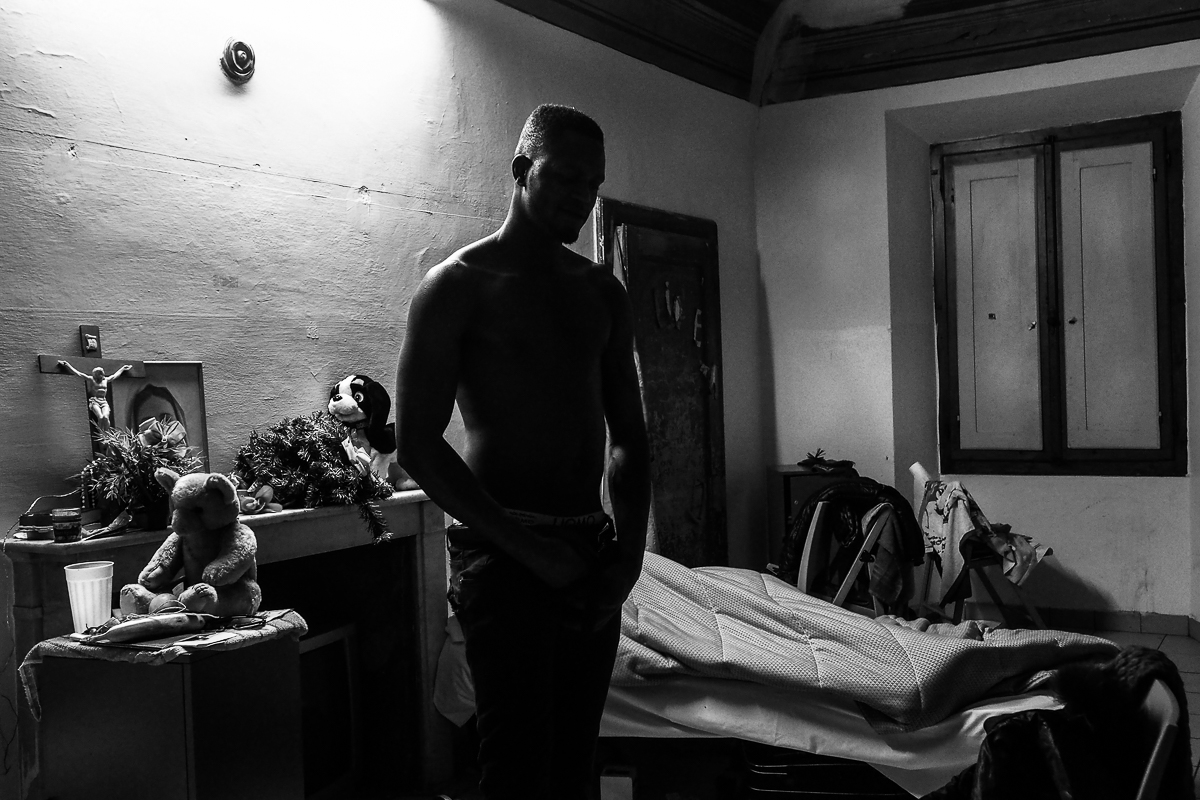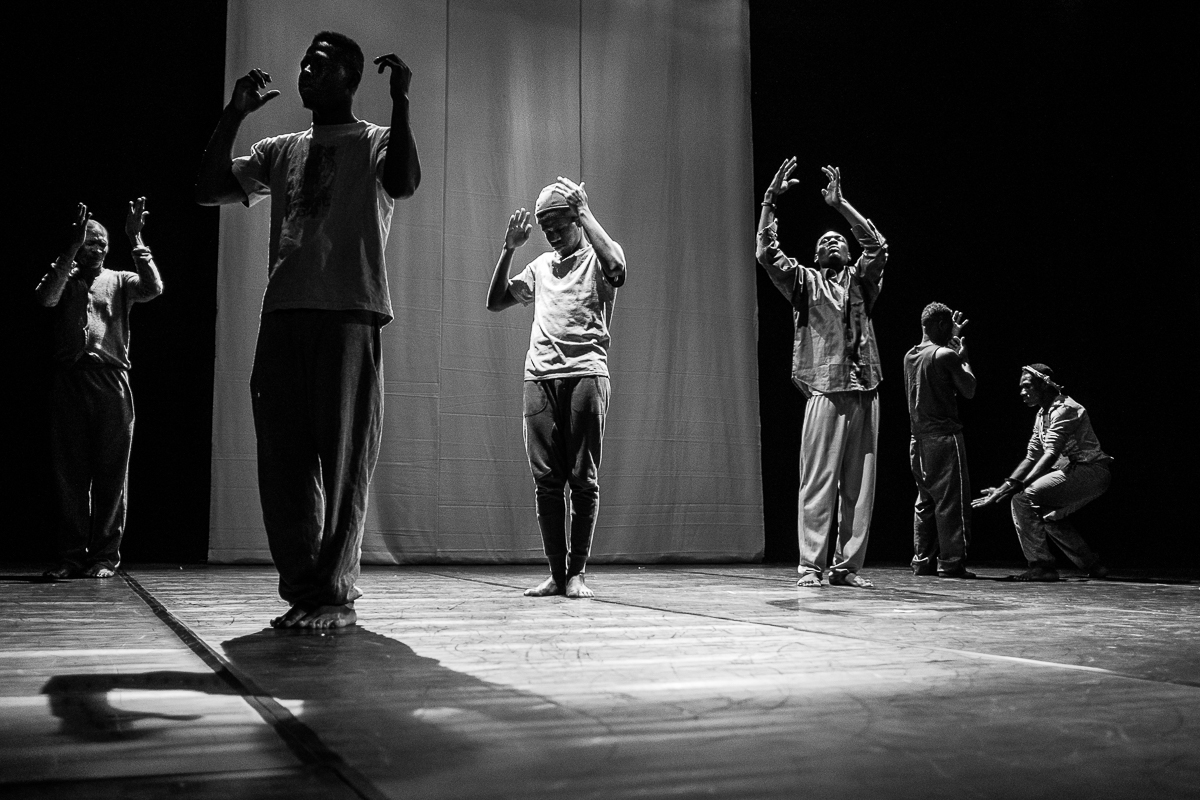NO LAND
The “no man’s land” stays between two borders: the one to quit and the one to reach. If you are trapped in the no man’s land you, your identity will be unclear, and the waiting will be your daily occupation. You will wait for the lunch and the dinner. You will wait for a job offer. You will wait for your ID card. You will want to know how your relatives remained in the other world are. You will wait for sleeping, for having breakfast, you will wait for someone that recognizes who you are. In the asylum seekers’ no man’s land you live a suspended life and you will wait for a new one that, perhaps, will be coming tomorrow.
In October 2017 I came in the no man’s land of a hundred asylum seekers hosted in the most equipped and well managed Prato’s reception centre, the Santa Caterina, owned by the catholic foundation Opera Santa Rita. And I am still inside. I have passed through the door by curiosity and to have a confirmation of my prejudices: if I would have found barbarians, invaders, worthless people. But I have found boys like the others. Only burdened by a death load.
I have followed boys aged from 18 and 30 years escaped for hunger, wars or terrorism from Bangladesh, Mali, Niger, Nigeria, Guinée, Liberia, Senegal, Sudan, Somalia in their everyday life: during Italian lessons, in the canteen, at their dance course, in their rare moments of sociality. Sometimes I had the privilege to obtain their confidences: they had survived the deserts crossing, to the tortures in Libya, to the crossing of the Mediterranean Sea, they had landed in Italy and instead of a new existence they had found the waiting.
“Asylum seekers stories are not the happy ending ones has told me a human operator, lawyer, specialised in the life reconstruction of those who escaped and asked for help, this because in Italy has always been huge hypocrisies. In the end, if the asylum seekers obtain a recognition or not, our system is not able to absorb them.”
Since the 1st June 2018, date of entry into force of the Italian Government led by the League Party, for the 102.000 asylum seekers landed in Italy (data from the Interior Ministry on 15 August 2019) to the practical and psychological difficulties to start a new life, has been added an evident sentiment of intolerance of a wide band of the Italian population. Inclination to rejection border on racism survived to the Government itself, fallen in August 2019.
There are still into force the so called “security decrees” desired by the former interior Minister Matteo Salvini. “The aim of this laws is clear- it’s the judgement of the provincial responsible in the Opera Santa Rita foundation who manage almost the half of the 800 foreigners hosted in the CAS- to hurdle the asylum seekers’ process of integration, by compromising, almost until delete the reception system”.
The Santa Caterina, like all the extraordinary hosting centre of Prato and other in Italy, can carry on thanks to the Government prorogation extended each six months, the last in September 2019 but each of them has maintenance cost per capita reductions. At the same time the expenses of the associations, ONLUS, foundations managing the receptions rise as the worries about the future and the determination to resist. For how long, no one knows.
NESSUNA TERRA
La “terra di nessuno” sta tra due frontiere: quella che si lascia e l’altra da raggiungere. Se si resta imprigionati nella terra di nessuno l’identità si fa incerta e l’attesa diventa occupazione quotidiana. Si aspettano il pranzo e la cena. Che qualcuno offra un posto di lavoro. Si aspetta il documento d’identità. Di sapere come stanno i parenti rimasti nell’altro mondo. Si aspetta di dormire, di fare colazione, che qualcuno ti riconosca per quel che sei. Nella “terra di nessuno” dei richiedenti asilo, si vive una vita sospesa e si aspetta quella nuova. Che arriverà, forse, domani.
Sono entrata nella “terra di nessuno” di un centinaio di richiedenti asilo, ospitati nel più attrezzato e ben gestito centro di accoglienza di Prato, il Santa Caterina, della fondazione cattolica Opera Santa Rita, nell’ottobre del 2017. E non ne sono ancora uscita. Ho varcato la porta per curiosità e voglia di capire se i pregiudizi che covavo avevano fondamento: se trovavo barbari, invasori, buoni a nulla. Invece, ho incontrato ragazzi. Solo, appesantiti da un fardello di morte.
Ho seguito giovani, tra i 18 e i 30 anni, fuggiti per fame, guerre o terrorismo da Bangladesh, Mali, Niger, Nigeria, Guinee, Liberia, Senegal, Sudan, Somalia, nella loro vita di tutti i giorni: a lezione di italiano, in mensa, ai corsi di danza, nei rari momenti di socialità. A volte ho avuto il privilegio di raccogliere le loro confidenze: sopravvissuti ai viaggi nel deserto, alle torture in Libia, alla traversata del Mediterraneo, sono sbarcati in Italia e invece di una nuova esistenza hanno trovato l’attesa.
“Quelle dei richiedenti asilo non sono storie a lieto fine – mi ha detto un giorno un operatore umanitario, avvocato, specializzato nella ricostruzione delle vite di chi fugge e chiede aiuto – In Italia c’è sempre stata una grande ipocrisia perché, alla fine, che i migranti ottengano o meno un riconoscimento, il nostro sistema non è in grado di assorbirli”.
A partire dal primo giugno 2018, data di entrata in vigore del governo italiano a trazione leghista, per i circa 102.000 richiedenti asilo sbarcati in Italia (dati ministero Interni al 15 agosto 2019) alle difficoltà pratiche e psicologiche di iniziare una vita, si è aggiunto un manifesto sentimento di intolleranza da parte di una larga fascia della popolazione italiana. Inclinazione al rifiuto al limite del razzismo sopravvissuta al governo stesso, caduto nell’agosto del 2019.
Sono rimasti in vigore anche i cosiddetti decreti sicurezza, voluti dall’ex ministro dell’Interno Matteo Salvini. “L’obiettivo delle leggi è chiaro – è il giudizio della responsabile provinciale della fondazione Opera Santa Rita che gestisce quasi la metà dei circa 800 stranieri accolti nei cas di Prato – ostacolare il processo di integrazione dei richiedenti asilo, compromettendo, fino quasi a cancellarlo, il sistema di accoglienza”.
Il Santa Caterina, come tutti gli altri centri di accoglienza straordinari d’Italia, vive grazie a proroghe governative ottenute di sei mesi in sei mesi – l’ultima in settembre 2019 – in ognuna delle quali viene tagliato il costo pro capite per il mantenimento dei richiedenti asilo. Contestualmente aumentano le spese delle associazioni, delle onlus, delle fondazioni che si occupano di accoglienza, la preoccupazione sul futuro e la determinazione a resistere. Per quanto ancora, nessuno lo può sapere.

















